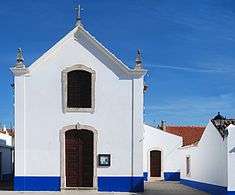Church of Porto Covo
| Church of Porto Covo (Igreja de Porto Covo) | |
| Church of Our Lady of Solitude | |
| Church (Igreja) | |
 The austere facade of the Baroque-style parochial church of Porto Covo | |
| Official name: Igreja de Nossa Senhora da Soledade | |
| Named for: Porto Covo | |
| Country | |
|---|---|
| Region | Alentejo |
| Subregion | Alentejo Litoral |
| District | Setúbal |
| Municipality | Sines |
| Location | Porto Covo |
| - elevation | 33 m (108 ft) |
| - coordinates | PT 37°51′5.05″N 8°47′29.71″W / 37.8514028°N 8.7915861°WCoordinates: PT 37°51′5.05″N 8°47′29.71″W / 37.8514028°N 8.7915861°W |
| Length | 14.90 m (49 ft), Northwest to Southeast |
| Width | 12.72 m (42 ft), Southwest to Northeast |
| Architects | Joaquim Guilherme d'Oliveira |
| Styles | Baroque, Neoclassic |
| Materials | Masonry stone, Wood, Azulejo |
| Origin | 18th century |
| Owner | Portuguese Republic |
| For public | Private |
| Visitation | Intermittent (Church is open irregularly, although not specifically for independent visits[1]) |
| Easiest access | Largo Marquês de Pombal |
| Management | Instituto Gestão do Patrimonio Arquitectónico e Arqueológico |
| Operator | Roman Catholic Diocese of Setúbal |
| Status | Unclassified |
The Church of Porto Covo (Portuguese: Igreja de Porto Covo) is Baroque and Neoclassic church in the civil parish, municipality of Sines, in the Atlantic coast of the Portuguese Alentejo. The church's austere lines is a morphological hybridization of the styles employed during the reign of Queen Maria I.[1] In the widespread typology of regional architecture, the Baroque elements are evident in the lintels and trim curves, framed in a composition that is, generally, more rigid then in the gable design.[1][2]
History
Around the end of the 18th century, the church was constructed within the remodelling of the Largo Marquês de Pombal by Joaquim Guilherme d'Oliveira.[1][2]
Architecture
The church is a rare example, important for the group details and composition, including pinnacles and triumphal arch, different from the vernacular characteristics of other temples of the same size in the region.[2]
The church is located in the centre of a large square (Largo Marquês de Pombal), aligned with trees and a central garden. It has a longitudinal plan, formed of a nave and a narrower presbytery, with lateral sacristy and tiled articulated spaces.[2] The principal facade is oriented towards the north, defined by accented corners, a finial gable crowned by a cross (resting on a plinth in masonry) and stone urns on plinths crowning the corners.[1][2] The church portal is an arched frame, surmounted by a big window with ornate semi-circular frame.[2] The lateral facades are simple with no doorways or windows.
Interior
The unique nave is covered in wood with three plans, with a lower footer in blue and white azulejo tile.[2] Within this space, framed by the same portal and window, to the right, is a basin for holy water, while a triumphal arch framed in stonework, with pilasters and single step.[2]
The presbytery is covered with vaulted-ceiling, with cornice, while the main altar is preceded by two steps and framed within a gilded retable.[2] A central rounded niche is flanked by pilasters with volutes and upper architecture in multiple lobes, framed by a medallion with the monogram AM circled by glint and urns.[1][2] On either side are corbels and false niches gilded and painted. On the left wall is a doorway to the sacristy.[2]
The church is constructed of stone masonry and mortar primarily, plastered and whitewashed, with the portal and secondary elements in stone.[2] In addition, the elements of the church include tile covering of straw, wood-lined ceilings with dome plastered and whitewashed, tiled floors, wooden window frames, gilded altarpiece and polychromatic tiles.[2]
References
- Notes
- 1 2 3 4 5 6 Câmara Municipal, ed. (2010), Igreja de Porto Covo (in Portuguese), Sines, Portugal: Câmara Municipal de Sines, retrieved 9 May 2012
- 1 2 3 4 5 6 7 8 9 10 11 12 13 Falcão, José; Pereira, Ricardo (1999), SIPA, ed., Igreja de Porto Covo (v. PT041513020014) (in Portuguese), Lisbon, Portugal: SIPA – Sistema de Informação para o Património Arquitectónico, archived from the original on 5 March 2016, retrieved 9 May 2012